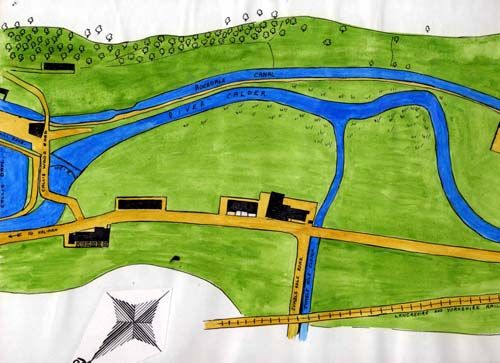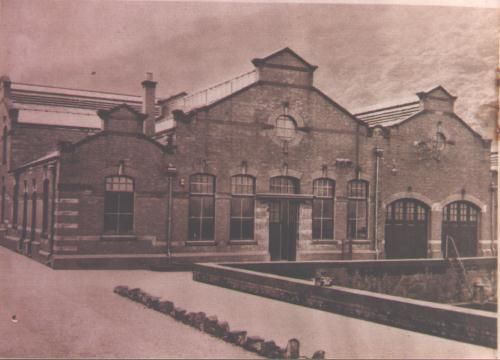Charlestown begins at the bridge over Jumble Hole Clough (361 feet above sea level). The bridge over the main road was known as Mutterhole Bridge and was built in 1768. In the 1880s it was known as Sand Bed Bridge. It was widened in 1830 and the present bridge was rebuilt in the 1900s when the river was diverted because of the building of the sewage works.


SANDBEDS (THE SEWAGE WORKS)
The sewage works was set up by Todmorden Council on the site of St. James cricket field (also called Mutterhole Plain or Mutterhole Holme). Callis dam and the land at Sandbed was bought for £9,254 with the total costs of £28,955 for completing the works . On 26th June 1901 the Mayor of Todmorden (Ald Wm. Ormerod) cut the first sod for the new sewage works, in the presence of the Town Council and the Borough officials and a large gathering of the good and the great. The spade presented to the mayor bore the following inscription:- Presented to the Mayor of Todmorden, Ald Wm Ormerod, Esq., J.P. of Scaitcliffe Hall by the contractors on the occasion of the cutting of the first sod by His Worship in connection with the river diversion for the sewage disposal works at Sandbed. June 26th 1901. Wm Jones & Co., contractors.
The re routing of the River Calder and straightening out the meanders has resulted in the continued flooding of Callis only recently alleviated by the building of a flood plain.

The present route runs parallel to the road.

The photographs below were saved when Yorkshire Water had a clear out. The staff created a small museum of artifacts, machinery and photographs, more details are on the archive page.



On 17th Oct 1908, the formal opening of the Sewage Disposal Works was carried out by Mayor Ald Abraham Crossley, followed by a Mayoral Banquet at the White Hart Hotel.

The works took seven years to build and cost £100,000.
In the early days of the sewage works, it has been said that local inhabitants stayed clear of the river on a Friday, because all the effluent was let out in one go. However, this seems unlikely as there has never been enough storage tanks to make this practice possible.
The sewage works were refurbished in 1926 with the removal of the detritus tanks (which separated grit from the rest of the incoming sewage) and the addition of circular filter beds.


This was removed in 2003 when the river walls were rebuilt.
BEVERLEY
The large house on this site which has recently been an old people's home was built in the 1930s by Minnie Lumb who owned the electrical shop on Market Street. She left because of the smell from the sewage works.

SANDBED
Sandbed Bridge which takes Jumble Hole Clough under the main road used to be a hump backed bridge and was the site of many motor bike accidents until it was evened out.
Opposite Beverley is a red brick building with a flat roof which used to be called Sandbed House. This was built in about 1890 by Tommy Jackson who had a theory that flat roofs were more practical than pitched roofs. Tommy and his father John were engineers and operated in an attached machine works called the smithy. John went around Yorkshire (in a top hat and morning suit) repairing the newly introduced farm machinery, while Thomas maintained machinery in local mills. Tommy Jackson retired by 1916 to look after his ageing father. He cycled every week to Eastwood Co-op wearing an old jacket and ancient cycling hat.
Sandbed House was left to Betty Cockroft in 1935 and she rented it to Richard Houghton for a few years before it was sold. It was later used as a garage run by Maurice Marney. Maurice was famous for his large collection of budgerigars which were kept in cages out the back.
Just after the Second World War it was taken over by CVS - an upper valley institution. CVS which stands for Calder Valley Salvage was started by three disabled servicemen (George Crowther and Jim Weeble). They bought a rag bag of items from Ministry sales, so you never knew what to expect. If you wanted something, but couldn't think who would sell it, CVS was always a first port of call. CVS turned into a builders merchants, but a fire in the 1980s destroyed most of the building. The building is now occupied by Ecoheat.
Next to CVS is a garage and tyre dealer called Murts Motor Centre. This started life before the war as a haulage business run by the Hursts who lived in Wood Villas. After the second world war it was called the Monteith Garage. Steve Murty describes mainly repairing vehicles built in the 1930s and 40s. Tyre regulations were non existent and bald tyres only discarded when they wore through the inner tubes.
In the 60s the garage got involved in building (mainly in the evenings and weekends!) and racing motorbikes. This led to Steve becoming the European sprint champion in 1972.
Murts is perhaps most famous as the home of the Ultimate Motor Stunts team who use large trucks to do wheelies at 100 mph - stunts that set a British landspeed record and put Steve Murty in the Guinness Book of Records (a video of the best stunts is sold at the garage).
The garage and tyre business continues.
RECREATION GROUND
This is now owned by Calderdale Council. The land used to be owned by the railway.
Original site of the recreation ground was where Beverley now stands. It had swings, a slide and a roundabout. When Beverley was built it was moved to its present site next to the old council tip.
A small terrace half way along (now demolished) called Bridge End contained a pie shop run by Tommy Knight. Opposite the recreation ground is a terrace built in the 1880s called Wood Villas. At the Easterly end of the recreation ground is a cottage called Dover (presumably being opposite to Callis/Calais Bridge). In 1837, records mention a beerhouse in the locality.
This page was last updated August 2009